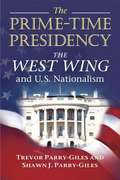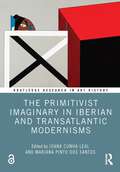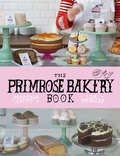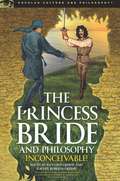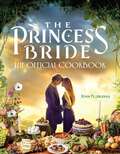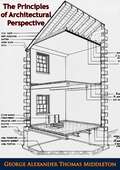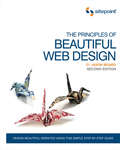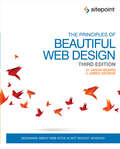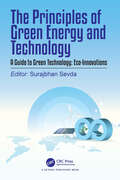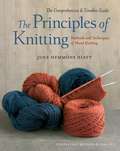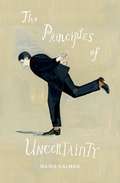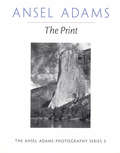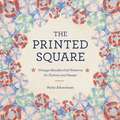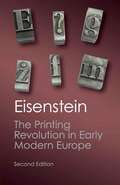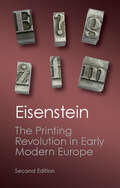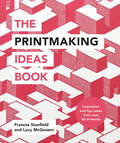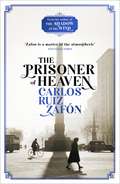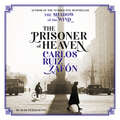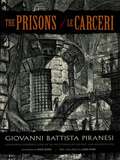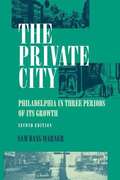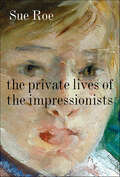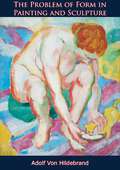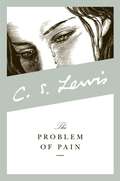- Table View
- List View
The Prime-Time Presidency: The West Wing and U.S. Nationalism
by Shawn J. Parry-GilesContrasting strong women and multiculturalism with portrayals of a heroic white male leading the nation into battle, The Prime-Time Presidency explores the NBC drama The West Wing, paying particular attention to its role in promoting cultural meaning about the presidency and U.S. nationalism. Based in a careful, detailed analysis of the "first term" of The West Wing's President Josiah Bartlet, this criticism highlights the ways the text negotiates powerful tensions and complex ambiguities at the base of U.S. national identity--particularly the role of gender, race, and militarism in the construction of U.S. nationalism. Unlike scattered and disparate collections of essays, Trevor Parry-Giles and Shawn J. Parry-Giles offer a sustained, ideologically driven criticism of The West Wing. The Prime-time Presidency presents a detailed critique of the program rooted in presidential history, an appreciation of television's power as a source of political meaning, and television's contribution to the articulation of U.S. national identity.
The Primitive, the Aesthetic, and the Savage: An Enlightenment Problematic
by Tony C. BrownTony C. Brown examines &“the inescapable yet infinitely troubling figure of the not-quite-nothing&” in Enlightenment attempts to think about the aesthetic and the savage. The various texts Brown considers—including the writings of Addison, Rousseau, Kant, and Defoe—turn to exotic figures in order to delimit the aesthetic, and to aesthetics in order to comprehend the savage.In his intriguing exploration Brown discovers that the primitive introduces into the aesthetic and the savage an element that proves necessary yet difficult to conceive. At its most profound, Brown explains, this element engenders a loss of confidence in one&’s ability to understand the human&’s relation to itself and to the world. That loss of confidence—what Brown refers to as a breach in anthropological security—traces to an inability to maintain a sense of self in the face of the New World. Demonstrating the impact of the primitive on the aesthetic and the savage, he shows how the eighteenth-century writers he focuses on struggle to define the human&’s place in the world. As Brown explains, these authors go back again and again to &“exotic&” examples from the New World—such as Indian burial mounds and Maori tattooing practice—making them so ubiquitous that they come to underwrite, even produce, philosophy and aesthetics.
The Primitivist Imaginary in Iberian and Transatlantic Modernisms (Routledge Research in Art History)
by Joana Cunha Leal Mariana Pinto dos SantosTaking into account politics, history, and aesthetics, this edited volume explores the main expressions of primitivism in Iberian and Transatlantic modernisms. Ten case studies are thoroughly analyzed concerning both the circulations and exchanges connecting the Iberian and Latin American artistic and literary milieus with each other and with the Parisian circles. Chapters also examine the patterns and paradoxes associated with the manifestations of primitivism, including their local implications and cosmopolitan drive. This book opens up and deepens the discussion of the ties that Spain and Portugal maintained with their imperial pasts, which extended into European twentieth-century colonialism, as well as the nationalist and folk aesthetics promoted by the cultural industry of Iberian dictatorships. The book significantly rethinks long-established ideas about modern art and the production of primitivist imagery. The book will be of interest to scholars working in art history, Iberian studies, Latin American studies, colonialism, and modernism. The Open Access version of this book, available at www.taylorfrancis.com, has been made available under a Creative Commons Attribution-Non Commercial-No Derivatives (CC-BY-NC-ND) 4.0 license.
The Primrose Bakery Book
by Lisa Thomas Martha SwiftThe Primrose Bakery is a way of life. From croissants for breakfast to layer cakes at tea, it has the whole day covered. And of course their signature buttercream cupcakes are delicious any time of day!With over 80 inspirational and easy-to-follow recipes for cupcakes, layer cakes, biscuits, loaves and much more, as well as tips like perfect icing, The Primrose Bakery Book is a baking bible. It is also a gorgeously quirky window onto the very special day-to-day world of the Primrose Bakery.
The Princess Bride and Philosophy: Inconceivable!
by Richard Greene Rachel Robison-GreeneThe Princess Bride is the 1987 satirical adventure movie that had to wait for the Internet and DVDs to become the most quoted of all cult classics. <P><P> The Princess Bride and Philosophy is for all those who have wondered about the true meaning of "Inconceivable!," why the name "Roberts" uniquely inspires fear, and whether it's truly a miracle to restore life to someone who is dead, but not necessarily completely dead. The Princess Bride is filled with people trying to persuade each other of various things, and invites us to examine the best methods of persuasion. It's filled with promises, some kept and some broken, and cries out for philosophical analysis of what makes a promise and why promises should be kept. It's filled with beliefs which go beyond the evidence, and philosophy can help us to decide when such beliefs can be justified. It's filled with political violence, both by and against the recognized government, and therefore raises all the issues of political philosophy. Westley, Buttercup, Prince Humperdinck, Inigo Montoya, the giant Fezzik, and the Sicilian Vizzini keep on re-appearing in these pages, as examples of philosophical ideas. Is it right for Montoya to kill the six-fingered man, even though there is no money in the revenge business? What's the best way to deceive someone who knows you're trying to deceive him? Are good manners a kind of moral virtue? Could the actions of the masked man in black truly be inconceivable even though real? What does ethics have to say about Miracle Max's pricing policy? How many shades of meaning can be conveyed by "As You Wish"?
The Princess Bride: Official Cookbook
by Jenn Fujikawa"As you dish!" Few films have captured the hearts and imaginations like The Princess Bride. Based on the book by William Goldman, the 1987 film, directed by Rob Reiner and starring Cary Elwes, Robin Wright, Mandy Patinkin, Billy Crystal, Andre the Giant, Carol Kane, Chris Sarandon, Wallace Shawn, Christopher Guest, Fred Savage, and Peter Falk is as universally beloved as it is quotable. Now, for the first time, The Princess Bride Cookbook: The Official Cookbook features more than 50 recipes for dishes seen in, and inspired by, the film, including: Buttercup Buttermilk Scones Hash You Wish Farm Boy Breakfast Six-Fingered Sandwiches Chips of Insanity MLT The Grandson&’s Soup and Sandwich Vizzini&’s Sicilian Meatballs Fezzik&’s Stew The Spaniard&’s Paella Bread Pirate Roberts Twu Wove&’s Kiss Cookies Iocane Powder Punch Inigo Montoya&’s Taste of Revenge Perfect for fans, families, and Brute Squads, The Princes Bride: The Official Cookbook is the ultimate way for home cooks to plate up the adventure, comedy, and romance of everyone&’s favorite film.
The Principles of Architectural Perspective: with Chapters on Isometric Drawings and the Preparation of Finished Perspectives
by George Alexander Thomas MiddletonAn efficiently arranged text book on perspective for the use of architectural draughtsmen. Its author, the architect G. A. T. Middleton (1861-1935), was for many years a leading figure in the Society of Architects, between 1884 and 1925 an independent breakaway group from the RIBA.
The Principles of Beautiful Web Design: 101 Essential Tips, Tricks And Hacks
by Jason BeairdThis second edition of The Principles of Beautiful Web Design is the ideal book for people who can build websites, but are seeking the skills and knowledge to visually enhance their sites.This book will teach you how to:Understand the process of what makes "good design," from discovery through to implementationUse color effectively, develop color schemes, and create a paletteCreate pleasing layouts using grids, the rule of thirds, and symmetryEmploy textures: lines, points, shapes, volumes, and depthApply typography to make ordinary designs look greatChoose, edit, and position effective imageryAnd lots more...This revised, easy-to-follow guide is illustrated with beautiful, full-color examples, and leads readers through the process of creating great designs from start to finish.It also features:Updated information about grid-based designHow to design for mobile resolutionsInformation about the future of web fonts including @font-faceCommon user-interface patterns and resources
The Principles of Beautiful Web Design: Designing Great Web Sites is Not Rocket Science!
by Jason Beaird James GeorgeThe Principles of Beautiful Web Design is the ideal book for people who can build websites, but are seeking the skills and knowledge to visually enhance their sites.This book will teach you how to:Understand what makes "good design," from discovery through to implementationUse color effectively, develop color schemes, and create a paletteCreate pleasing layouts using grids, the rule of thirds, and symmetryEmploy textures: lines, points, shapes, volumes, and depthApply typography to make ordinary designs look greatChoose, edit, and position effective imageryAnd lots more...This easy-to-follow guide is illustrated with beautiful, full-color examples, and will lead you through the process of creating great designs from start to finish. The third edition of this book has been greatly revised and now features:Updated and expanded coverage of mobile and responsive web design (RWD)A new sample projectNew sections on user interface and icon designCommon user-interface patterns and resources
The Principles of Green Energy and Technology, Volume 2: A Guide to Green Technology: Eco-Innovations
by Surajbhan SevdaThe Principles of Green Energy and Technology: A Guide to Green Technology: Eco-Innovations presents a comprehensive exploration of sustainable energy solutions and innovative technologies shaping our transition toward a low-carbon future. Covering critical topics such as biomass utilization, fuel stoichiometry, flue gas analysis, waste-to energy conversion, smart grids, and energy storage for solar power, the book offers in-depth insights into current and future energy systems. It also addresses global renewable resources, fossil fuel reserves, and pollution sources from conventional energy technologies, making it an essential guide for researchers, professionals, and students in the field of green energy and sustainability.
The Principles of Knitting
by June Hemmons HiattThe definitive book of knitting techniquesA word-of-mouth phenomenon since its original publication, with a passionate and loyal following, The Principles of Knitting has served as a treasured resource for an entire generation of knitters. Now completely revised and updated, this long-awaited new edition contains indispensable information for every knitter, from the beginner to the most experienced, on all aspects of the craft.Written in clear, direct language, The Principles of Knitting is like having a knitting mentor by your side, ready to answer any question in a comprehensive, reasoned, and informed manner. June Hemmons Hiatt includes instructions for all facets of knitting, from the most basic skills to the most advanced techniques, and offers suggestions for best practices as well as alternatives and innovations.The Principles of Knitting provides the inspiration and instruction to help every knitter gain the knowledge and confidence needed to produce unique, beautifully crafted garments, accessories, and household items. It is the one reference guide no knitter should be without.The classic work on this timeless and important craft
The Principles of Uncertainty
by Maira KalmanThe Principles of Uncertainty is an irresistible invitation to experience life through the psyche of Maira Kalman, one of this country's most beloved artists.
The Print (Ansel Adams Photography Ser. #Vol. 3)
by Ansel Adams Robert BakerThe Print is the third and final book in the seminal Ansel Adams Photography Series. The Print belongs on every photographer's shelf. It covers the entire printmaking process, from designing and furnishing a darkroom and experimenting with your first print, to mastering advanced techniques such as developer modifications, toning, and bleaching, and burning and dodging. This thorough guide is filled with indispensable darkroom techniques and tips. It is an indispensable tool for mastering the complex art of photographic printmaking. Photographs, instuctional line drawings.
The Printed Square: Vintage Handkerchief Patterns for Fashion and Design
by Nicky AlbrechtsenShowcasing a wealth of arresting color combinations, weaves, and patterns in more than 200 gorgeous examples, The Printed Square by Nicky Albrechtsen reveals the hidden history of the fashionable handkerchief. Period photographs, an analysis of fabric and design trends, and detailed information on collecting vintage handkerchiefs make this one-of-a-kind treasure a must-have for style mavens and fashionistas, lovers of vintage clothes, and designers of all disciplines.
The Printing Revolution in Early Modern Europe (Canto Classics Series)
by Elizabeth L. EisensteinIn 1979 Elizabeth Eisenstein provided the first full-scale treatment of the fifteenth-century printing revolution in the West in her monumental two-volume work, The Printing Press as an Agent of Change. <p><p>This abridged edition, after summarising the initial changes introduced by the establishment of printing shops, goes on to discuss how printing challenged traditional institutions and affected three major cultural movements: the Renaissance, the Reformation, and the rise of modern science. Also included is a later essay which aims to demonstrate that the cumulative processes created by printing are likely to persist despite the recent development of new communications technologies.
The Printing Revolution in Early Modern Europe (Canto Classics)
by Elizabeth L. EisensteinAlthough the importance of the advent of printing for the Western world has long been recognized, it was Elizabeth Eisenstein, in her monumental, two-volume work, The Printing Revolution in Early Modern Europe, who provided the first full-scale treatment of the subject. This illustrated and abridged edition gives a stimulating survey of the communications revolution of the fifteenth century. After summarizing the initial changes introduced by the establishment of printing shops, it goes on to discuss how printing affected three major cultural movements: the Renaissance, the Reformation, and the rise of modern science. This new edition includes a new essay discussing recent controversies provoked by the first edition and reaffirms the thesis that the advent of printing entailed a communications revolution. Fully-illustrated and annotated, the book argues that the cumulative processes set in motion with the advent of printing are likely to persist despite the recent development of new communications technologies.
The Printmaking Ideas Book
by Frances Stanfield Lucy McGeownWhether you're discovering printmaking for the first time or you're looking for fresh ideas to reinvigorate your practice, you'll find plenty of inspiration in The Printmaking Ideas Book.From traditional methods such as screenprinting, etching and lithography to contemporary techniques such as risography and digital collage, this book is packed with new ideas, methods and tips on every page.Brimming with experimental, arresting and beautiful examples of printmaking from all over the world, it will take your creativity further and awaken new ideas.
The Printmaking Ideas Book
by Frances Stanfield Lucy McGeownFrom traditional methods such as screenprinting, etching and lithography to contemporary techniques such as risography and digital collage, this book is packed with new ideas, methods and tips on every page.Brimming with experimental, arresting and beautiful examples of printmaking from all over the world, it will take your creativity further and awaken new ideas.
The Prisoner of Heaven: The Cemetery of Forgotten Books 3
by Carlos Ruiz ZafonTHE PRISONER OF HEAVEN returns to the world of the Cemetery of Forgotten Books and the Sempere & Sons bookshop.It begins just before Christmas in Barcelona in 1957, one year after Daniel and Bea from THE SHADOW OF THE WIND have married. They now have a son, Julian, and are living with Daniel's father at Sempere & Sons. Fermin still works with them and is busy preparing for his wedding to Bernarda in the New Year. However something appears to be bothering him.Daniel is alone in the shop one morning when a mysterious figure with a pronounced limp enters. He spots one of their most precious volumes that is kept locked in a glass cabinet, a beautiful and unique illustrated edition of THE COUNT OF MONTE CRISTO. Despite the fact that the stranger seems to care little for books, he wants to buy this expensive edition. Then, to Daniel's surprise, the man inscribes the book with the words 'To Fermin Romero de Torres, who came back from the dead and who holds the key to the future'. This visit leads back to a story of imprisonment, betrayal and the return of a deadly rival ...
The Prisoner of Heaven: The Cemetery of Forgotten Books 3
by Carlos Ruiz ZafonTHE PRISONER OF HEAVEN returns to the world of the Cemetery of Forgotten Books and the Sempere & Sons bookshop.It begins just before Christmas in Barcelona in 1957, one year after Daniel and Bea from THE SHADOW OF THE WIND have married. They now have a son, Julian, and are living with Daniel's father at Sempere & Sons. Fermin still works with them and is busy preparing for his wedding to Bernarda in the New Year. However something appears to be bothering him.Daniel is alone in the shop one morning when a mysterious figure with a pronounced limp enters. He spots one of their most precious volumes that is kept locked in a glass cabinet, a beautiful and unique illustrated edition of THE COUNT OF MONTE CRISTO. Despite the fact that the stranger seems to care little for books, he wants to buy this expensive edition. Then, to Daniel's surprise, the man inscribes the book with the words 'To Fermin Romero de Torres, who came back from the dead and who holds the key to the future'. This visit leads back to a story of imprisonment, betrayal and the return of a deadly rival ...Read by Peter Kenny(p) 2012 Orion Publishing Group
The Prisons / Le Carceri
by John Howe Giovanni Battista Piranesi Philip HoferThe timeless Carceri etchings of Piranesi (1720-1778) represent not only spectacular artistic accomplishments but also unforgettable expressions of psychological truths. Combining the influences of Tiepolo, Bibiena, and Rembrandt, these works of architectural fantasy challenge the boundaries of perception, creating a vast system of visual provocation. Innumerable staircases, immense vaults, and other ambiguous structures are compounded with projecting beams, pulleys, rickety catwalks and gangways, dangling ropes and chains, and the occasional shadowy human figure.This full reproduction in book form of The Prisons, made directly from mint copies of original prints, presents both editions of Piranesi's work, with prints on facing pages for convenient comparison. The first edition (circa 1745) ranks among the most rare and valuable print collections in existence and abounds in a multiplicity of perspectives--an innovation that predates Cubism by two centuries. For the second (1761) edition, Piranesi reworked the plates, adding elaborate details that alter some of them almost beyond recognition. It is in the second, more emotionally challenging renditions that his masterful management of light and shadow is most evident. This edition features an informative Introduction by Philip Hofer, in addition to a Preface by John Howe, a conceptual designer on Peter Jackson's Lord of the Rings film trilogy.
The Private City: Philadelphia In Three Periods Of Its Growth
by Sam Bass WarnerThis award-winning book charts the unfolding, from the Revolutionary War to the Great Depression, of the American tradition of city building and city living, using Philadelphia as a resonant example.
The Private Lives of the Impressionists
by Sue RoeThe New York Times–bestselling biography of Manet, Cezanne, Degas, and others—a “revealing group portrait . . . lively, required reading” (People).Though they were often ridiculed or ignored by their contemporaries, their paintings are now revered around the world. Their dazzling works are familiar to even the most casual art lovers—but how well do we know the Impressionists as people? The first book to offer an intimate and lively biography of the world’s most popular group of artists, including Manet, Monet, Pissarro, Cézanne, Renoir, Degas, Sisley, Morisot, and Cassatt.Sue Roe’s Private Lives of the Impressionists, follows an extraordinary group of artists into their Paris studios, down the rural lanes of Montmartre, and into the rowdy riverside bars of a city undergoing monumental change. Vivid and deeply researched, it casts a brilliant light on this unparalleled society of genius colleagues who lived and worked together for twenty years—and transformed the art world with their breathtaking depictions of ordinary life.
The Problem of Form in Painting and Sculpture
by Adolf Von HildebrandAdolf von Hildebrand (6 October 1847 – 18 January 1921) was a German sculptor.Hildebrand was born at Marburg, the son of Marburg economics professor Bruno Hildebrand. He studied at the Academy of Fine Arts Nuremberg, with Kaspar von Zumbusch at the Munich Academy and with Rudolf Siemering in Berlin. From 1873 he lived in Florence in the St Francesco Monastery, a secularized sixteenth-century monastery.A friend of Hans von Marées, he designed the architectural setting for the painter's murals in the library of the German Marine Zoological Institute at Naples (1873). He spent a significant amount of time in Munich after 1889, executing a monumental fountain there, the Wittelsbacher Brunnen. He is known for five monumental urban fountains and for the Bismarck monument in Bremen, unveiled in 1910.Hildebrand worked in a Neo-classical tradition, and set out his artistic theories in his book Das Problem der Form in der Bildenden Kunst ("The Problem of Form in Painting and Sculpture"), published in 1893.He died in Munich in 1921.
The Problem of Pain (C. S. Lewis Signature Classic Ser.)
by C. S. LewisIn The Problem of Pain, C.S. Lewis, one of the most renowned Christian authors and thinkers, examines a universally applicable question within the human condition: "If God is good and all-powerful, why does he allow his creatures to suffer pain?" With his signature wealth of compassion and insight, C.S. Lewis offers answers to these crucial questions and shares his hope and wisdom to help heal a world hungering for a true understanding of human nature.
